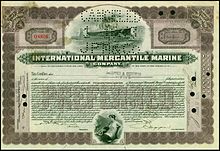
Back International Mercantile Marine Company German International Mercantile Marine Company Spanish International Mercantile Marine Co. French International Mercantile Marine Company ID International Mercantile Marine Company Dutch International Mercantile Marine Company NB International Mercantile Marine Co. Portuguese International Mercantile Marine Company Russian International Mercantile Marine Company Ukrainian 國際商業海洋公司 Chinese
 | |
| Company type | Public |
|---|---|
| Industry | Shipping |
| Founded | October 17, 1904 |
| Founders | |
| Defunct | 1931 |
| Fate | Merged with Roosevelt Steamship Company to form Roosevelt International Mercantile Marine Company |
The International Mercantile Marine Company, originally the International Navigation Company, was a trust formed in the early twentieth century as an attempt by J.P. Morgan to monopolize the shipping trade.
IMM was founded by shipping magnates Clement Griscom of the American Line and Red Star Line, Bernard N. Baker of the Atlantic Transport Line, J. Bruce Ismay of the White Star Line, and John Ellerman of the Leyland Line. The Dominion Line was also amalgamated. The project was bankrolled by J.P. Morgan & Co., led by financier J. P. Morgan. The company also had working profit-sharing relationships with the German Hamburg-Amerika and the North German Lloyd lines. The trust caused great concern in the British shipping industry and led directly to the British government's subsidy of the Cunard Line's new ships RMS Lusitania and RMS Mauretania in an effort to compete.
IMM was a holding company that controlled subsidiary corporations that had their own subsidiaries. Morgan hoped to dominate transatlantic shipping through interlocking directorates and contractual arrangements with the railroads, but that proved impossible because of the nature of sea transport, American antitrust legislation, and an agreement with the British government. One of IMM's subsidiaries was the White Star Line, which owned the RMS Titanic. Analysis of financial records shows that IMM was overleveraged and suffered from inadequate cash flow that caused it to default on bond interest payments in late 1914. As a result, a "friendly" receivership was put in effect in 1915, which allowed IMM to reorganize its finances; it emerged from the receivership in 1916.[1] Saved by World War I, IMM eventually re-emerged, after a merger with Roosevelt Steamship Company, as the United States Lines, which itself went bankrupt in 1986.[2]
A proposed subsidy bill in the United States Congress failed, which became widely apparent by April 1902 [a] and the company thus was never truly successful. Beginning in the 1920s, the company underwent a series of corporate acquisitions and mergers, which resulted in its becoming the United States Lines in 1943.
- ^ "IMM 1916 Annual Report" The New York Times, 4 April 1915; .
- ^ Clark, John J.; Clark, Margaret T. (1997), "The International Mercantile Marine Company: A Financial Analysis", American Neptune, 57 (2): 137–154
- ^ Vale 1984, pp. 94–97.
Cite error: There are <ref group=lower-alpha> tags or {{efn}} templates on this page, but the references will not show without a {{reflist|group=lower-alpha}} template or {{notelist}} template (see the help page).